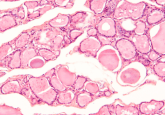First-of-its-kind natural history study of fibrodysplasia ossificans progressive demonstrates the significant impact of the disease

In a new natural history study, researchers have confirmed the progressive nature of fibrodysplasia ossificans progressive and identified important characteristics of the disease in a global population of individuals.
Fibrodysplasia ossificans progressive (FOP) is a very rare genetic disorder caused by a mutation in the ACVR1 gene, which affects the connective tissues. It is generally characterized by congenital malformations of the big toes, and progressive heterotopic ossification (HO; bone growth in tissues where it typically wouldn’t occur, such as the ligaments, tendons and skeletal muscles). Flare-ups occur periodically, and people with FOP experience increased difficulty with mobility over time, as the development of bone affects the soft tissue of the joints.
In a natural history study, researchers follow a selected population over time, who either have or are identified as being at risk of developing a particular condition. In the case of rare diseases such as FOP, which is estimated to affect 4000 individuals worldwide (with ~900 known patients), this information is particularly valuable.
In this recent study sponsored by Ipsen, the first global prospective study of its kind, 114 people with FOP were enrolled from eight study sites across six countries and followed for up to 3 years, to learn about the impact and progression of the disease over time. Findings included that mean volume of HO increased over time, and that 71.9% of participants experienced at least one flare-up over 3 years, most commonly in those aged 2–<8 years (88.2%). Individuals also experience restricted pulmonary function, from moderate restriction in younger individuals to more severe restriction in the older participants. It was also found that 90.2% of participants started using a new assistive device (such as bedroom aids and devices) or adaptation (such as starting to have a care assistant) over the course of the study.
“Natural history studies are essential to understanding ultra-rare diseases with high unmet need like FOP, increasing our knowledge around the natural course of disease, diagnoses, monitoring techniques, potential biomarkers and new outcome measures,” said lead author Dr Robert Pignolo (Mayo Clinic, MN, USA). “This is the first study of its kind following the progression of FOP over 3 years. These results demonstrate the significant impact of the disease on people living with FOP. Furthermore, it will facilitate the evaluation of meaningful endpoints in the development of new therapies, which are critically needed for individuals with FOP.”
Want regular updates on the latest real-world evidence news straight to your inbox? Become a member on The Evidence Base® today>>>





